Mohammad Jafari
RODEO: Robust Outlier Detection via Exposing Adaptive Out-of-Distribution Samples
Jan 28, 2025Abstract:In recent years, there have been significant improvements in various forms of image outlier detection. However, outlier detection performance under adversarial settings lags far behind that in standard settings. This is due to the lack of effective exposure to adversarial scenarios during training, especially on unseen outliers, leading to detection models failing to learn robust features. To bridge this gap, we introduce RODEO, a data-centric approach that generates effective outliers for robust outlier detection. More specifically, we show that incorporating outlier exposure (OE) and adversarial training can be an effective strategy for this purpose, as long as the exposed training outliers meet certain characteristics, including diversity, and both conceptual differentiability and analogy to the inlier samples. We leverage a text-to-image model to achieve this goal. We demonstrate both quantitatively and qualitatively that our adaptive OE method effectively generates ``diverse'' and ``near-distribution'' outliers, leveraging information from both text and image domains. Moreover, our experimental results show that utilizing our synthesized outliers significantly enhances the performance of the outlier detector, particularly in adversarial settings.
Killing it with Zero-Shot: Adversarially Robust Novelty Detection
Jan 25, 2025



Abstract:Novelty Detection (ND) plays a crucial role in machine learning by identifying new or unseen data during model inference. This capability is especially important for the safe and reliable operation of automated systems. Despite advances in this field, existing techniques often fail to maintain their performance when subject to adversarial attacks. Our research addresses this gap by marrying the merits of nearest-neighbor algorithms with robust features obtained from models pretrained on ImageNet. We focus on enhancing the robustness and performance of ND algorithms. Experimental results demonstrate that our approach significantly outperforms current state-of-the-art methods across various benchmarks, particularly under adversarial conditions. By incorporating robust pretrained features into the k-NN algorithm, we establish a new standard for performance and robustness in the field of robust ND. This work opens up new avenues for research aimed at fortifying machine learning systems against adversarial vulnerabilities. Our implementation is publicly available at https://github.com/rohban-lab/ZARND.
Universal Novelty Detection Through Adaptive Contrastive Learning
Aug 20, 2024
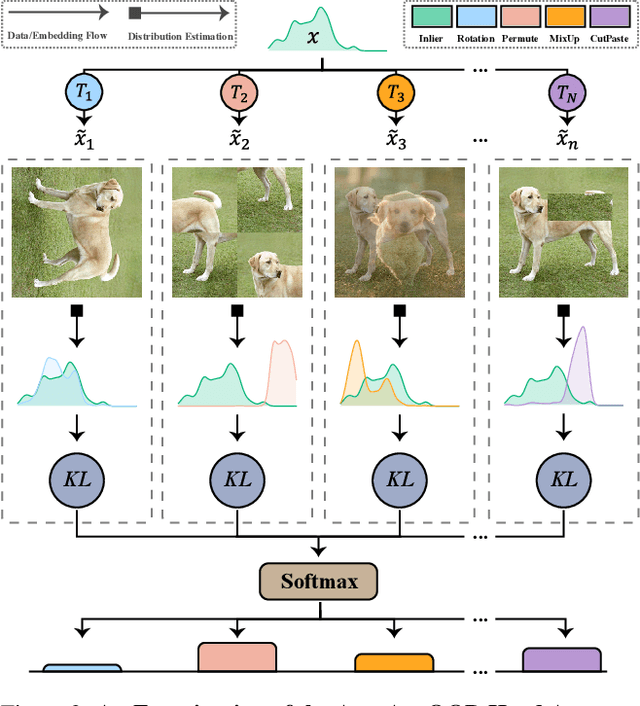


Abstract:Novelty detection is a critical task for deploying machine learning models in the open world. A crucial property of novelty detection methods is universality, which can be interpreted as generalization across various distributions of training or test data. More precisely, for novelty detection, distribution shifts may occur in the training set or the test set. Shifts in the training set refer to cases where we train a novelty detector on a new dataset and expect strong transferability. Conversely, distribution shifts in the test set indicate the methods' performance when the trained model encounters a shifted test sample. We experimentally show that existing methods falter in maintaining universality, which stems from their rigid inductive biases. Motivated by this, we aim for more generalized techniques that have more adaptable inductive biases. In this context, we leverage the fact that contrastive learning provides an efficient framework to easily switch and adapt to new inductive biases through the proper choice of augmentations in forming the negative pairs. We propose a novel probabilistic auto-negative pair generation method AutoAugOOD, along with contrastive learning, to yield a universal novelty detector method. Our experiments demonstrate the superiority of our method under different distribution shifts in various image benchmark datasets. Notably, our method emerges universality in the lens of adaptability to different setups of novelty detection, including one-class, unlabeled multi-class, and labeled multi-class settings. Code: https://github.com/mojtaba-nafez/UNODE
The Power of Few: Accelerating and Enhancing Data Reweighting with Coreset Selection
Mar 20, 2024



Abstract:As machine learning tasks continue to evolve, the trend has been to gather larger datasets and train increasingly larger models. While this has led to advancements in accuracy, it has also escalated computational costs to unsustainable levels. Addressing this, our work aims to strike a delicate balance between computational efficiency and model accuracy, a persisting challenge in the field. We introduce a novel method that employs core subset selection for reweighting, effectively optimizing both computational time and model performance. By focusing on a strategically selected coreset, our approach offers a robust representation, as it efficiently minimizes the influence of outliers. The re-calibrated weights are then mapped back to and propagated across the entire dataset. Our experimental results substantiate the effectiveness of this approach, underscoring its potential as a scalable and precise solution for model training.
HealNet -- Self-Supervised Acute Wound Heal-Stage Classification
Jun 23, 2022



Abstract:Identifying, tracking, and predicting wound heal-stage progression is a fundamental task towards proper diagnosis, effective treatment, facilitating healing, and reducing pain. Traditionally, a medical expert might observe a wound to determine the current healing state and recommend treatment. However, sourcing experts who can produce such a diagnosis solely from visual indicators can be difficult, time-consuming and expensive. In addition, lesions may take several weeks to undergo the healing process, demanding resources to monitor and diagnose continually. Automating this task can be challenging; datasets that follow wound progression from onset to maturation are small, rare, and often collected without computer vision in mind. To tackle these challenges, we introduce a self-supervised learning scheme composed of (a) learning embeddings of wound's temporal dynamics, (b) clustering for automatic stage discovery, and (c) fine-tuned classification. The proposed self-supervised and flexible learning framework is biologically inspired and trained on a small dataset with zero human labeling. The HealNet framework achieved high pre-text and downstream classification accuracy; when evaluated on held-out test data, HealNet achieved 97.7% pre-text accuracy and 90.62% heal-stage classification accuracy.
The multi-channel potentiostat: Development and Evaluation of a Scalable Mini-Potentiostat array for investigating electrochemical reaction mechanisms
May 20, 2021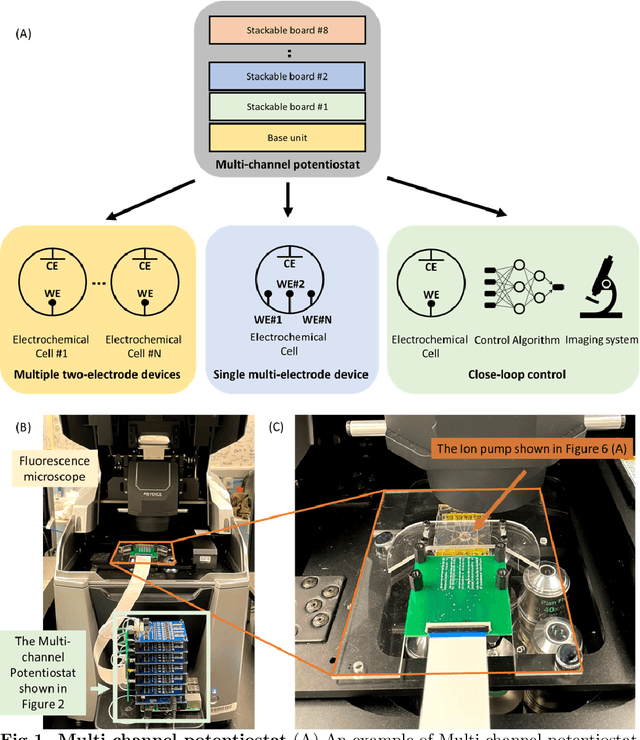
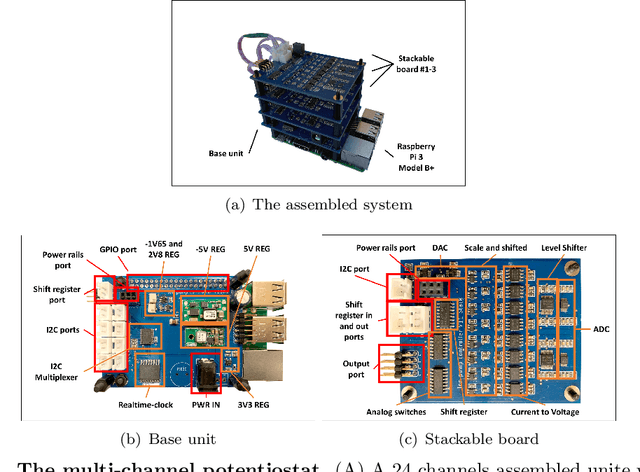
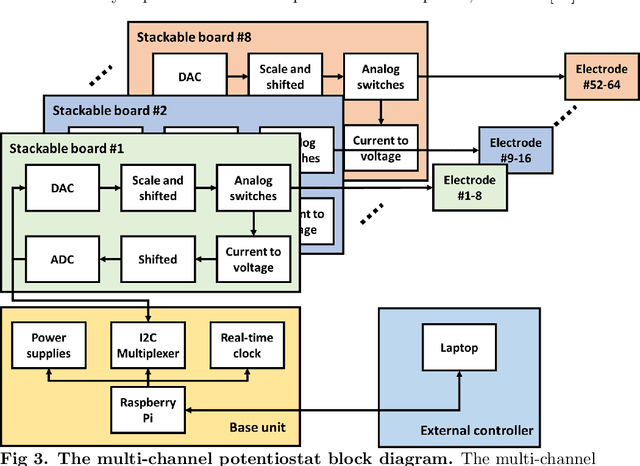
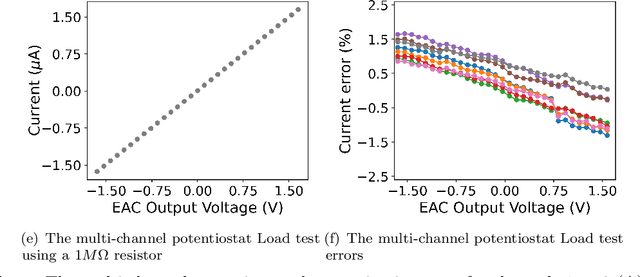
Abstract:A potentiostat is an essential piece of analytical equipment for studying electrochemical devices and reactions. As the design of electrochemical devices evolve applications for systems with multiple working electrodes have become more common. These applications drive a need for low-cost multi-channel potentiostat systems. We have developed a portable low-cost scalable system with a modular design that can support 8 to 64 channels at a cost as low as \$8 per channel. This design can replace the functionality of commercial potentiostats which cost upwards of \$10k for certain applications. Each channel in the multi-channel potentiostat has an independent adjustable voltage source with a built-in ammeter and switch, making the device flexible for various configurations. The multi-channel potentiostat is designed for low current applications (nA range), but its purpose can change by varying its shunt resistor value. The system can either function as a standalone device or remotely controlled. We demonstrate the functionality of this system for the control of a 24-channel bioelectronic ion pump for open- and closed- loop control of pH.
Reciprocal Landmark Detection and Tracking with Extremely Few Annotations
Jan 27, 2021



Abstract:Localization of anatomical landmarks to perform two-dimensional measurements in echocardiography is part of routine clinical workflow in cardiac disease diagnosis. Automatic localization of those landmarks is highly desirable to improve workflow and reduce interobserver variability. Training a machine learning framework to perform such localization is hindered given the sparse nature of gold standard labels; only few percent of cardiac cine series frames are normally manually labeled for clinical use. In this paper, we propose a new end-to-end reciprocal detection and tracking model that is specifically designed to handle the sparse nature of echocardiography labels. The model is trained using few annotated frames across the entire cardiac cine sequence to generate consistent detection and tracking of landmarks, and an adversarial training for the model is proposed to take advantage of these annotated frames. The superiority of the proposed reciprocal model is demonstrated using a series of experiments.
Adaptive Intelligent Secondary Control of Microgrids Using a Biologically-Inspired Reinforcement Learning
May 02, 2019



Abstract:In this paper, a biologically-inspired adaptive intelligent secondary controller is developed for microgrids to tackle system dynamics uncertainties, faults, and/or disturbances. The developed adaptive biologically-inspired controller adopts a novel computational model of emotional learning in mammalian limbic system. The learning capability of the proposed biologically-inspired intelligent controller makes it a promising approach to deal with the power system non-linear and volatile dynamics without increasing the controller complexity, and maintain the voltage and frequency stabilities by using an efficient reference tracking mechanism. The performance of the proposed intelligent secondary controller is validated in terms of the voltage and frequency absolute errors in the simulated microgrid. Simulation results highlight the efficiency and robustness of the proposed intelligent controller under the fault conditions and different system uncertainties compared to other benchmark controllers.
Applied Neural Cross-Correlation into the Curved Trajectory Detection Process for Braitenberg Vehicles
Oct 13, 2014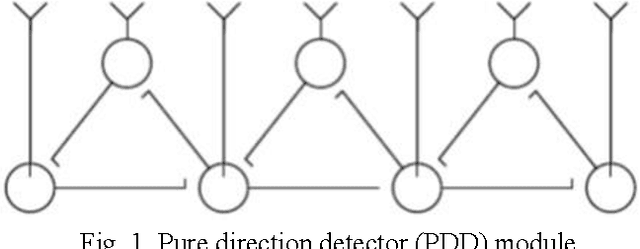
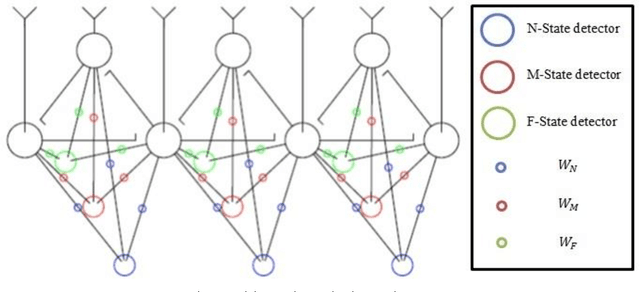
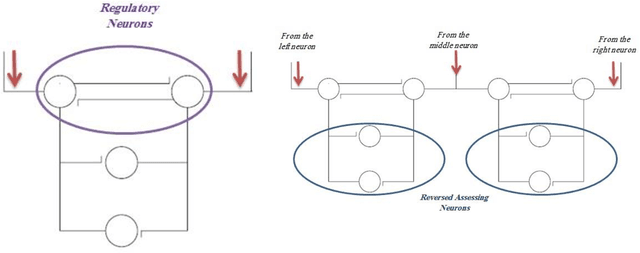
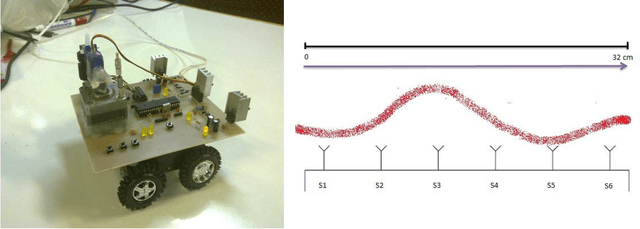
Abstract:Curved Trajectory Detection (CTD) process could be considered among high-level planned capabilities for cognitive agents, has which been acquired under aegis of embedded artificial spiking neuronal circuits. In this paper, hard-wired implementation of the cross-correlation, as the most common comparison-driven scheme for both natural and artificial bionic constructions named Depth Detection Module(DDM), has been taken into account. It is manifestation of efficient handling upon epileptic seizures due to application of both excitatory and inhibitory connections within the circuit structure. Presented traditional analytic approach of the cross-correlation computation with regard to our neural mapping technique and the acquired traced precision have been turned into account for coherent accomplishments of the aforementioned design in perspective of the desired accuracy upon high-level cognitive reactions. Furthermore, the proposed circuit could be fitted into the scalable neuronal network of the CTD, properly. Simulated denouements have been captured based on the computational model of PIONEER mobile robot to verify characteristics of the module, in detail.
 Add to Chrome
Add to Chrome Add to Firefox
Add to Firefox Add to Edge
Add to Edge